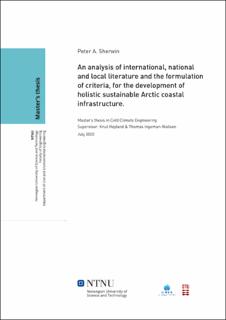| dc.contributor.advisor | Høyland, Knut Vilhelm | |
| dc.contributor.advisor | Ingeman-Nielsen, Thomas | |
| dc.contributor.advisor | Aalberg, Arne | |
| dc.contributor.author | Sherwin, Peter A. | |
| dc.date.accessioned | 2021-09-20T16:22:47Z | |
| dc.date.available | 2021-09-20T16:22:47Z | |
| dc.date.issued | 2020 | |
| dc.identifier | no.ntnu:inspera:57484280:61309759 | |
| dc.identifier.uri | https://hdl.handle.net/11250/2779486 | |
| dc.description.abstract | Hurtige endringer i det arktiske sosialøkologiske system påvirker eksisterende bygd infrastruktur i en negativ grad, i tillegg til å øke interessen for dens videre utvikling. Grunnet ekspanderende næringer, samt Arktis’ ømfintlige økosystem, står Arktis på et balansepunkt mellom bærekraftig utvikling og utvikling som er skadelig for både Arktis og resten av verden. Det er derfor et behov for veiledning om hvordan bygd infrastruktur bør utvikles, som igjen gir opphav til forskningsspørsmålet: Hva er bærekraftig arktisk kystinfrastruktur som en helhet, og hvordan kan dette oppnås i fremtidig utvikling?
Litteraturstudie, i tillegg til undersøkelser og intervjuer med fagfolk innenfor bygd infrastruktur, har blitt brukt til å vurdere den nåværende litteraturdefinerte retningen innen arktisk utvikling, samt fremtredende mangler og begrensninger i denne litteraturen. Gjennom denne prosessen konkluderes det med at det er et betydelig behov for økt veiledning og kunnskapsoverføring til beslutningstakere på alle nivåer på tvers av Arktis. Det er særlig mangel på kunnskap innen kystsonene.
Det foretas en generell og arktisk gjennomgang av den historiske og nåværende forståelsen av bærekraftig utvikling, og indikatorer for utvikling og bærekraft bestemmes. Man anerkjenner at den arktiske utviklingen i dag er antroposentrisk, og en ny bærekraftig utviklingsmodell er tenkt ut. Bygd infrastruktur identifiseres som en essensiell kobling mellom menneskeheten og naturen, samt at den bygde infrastrukturens rolle er å oppnå en eksistens innenfor økologiske rammer, og dermed prioritere verdens begrensninger fremfor å takle verdens vekstproblemer.
Det konkluderes med at en helhetlig bærekraftig utvikling innen arktisk kystinfrastruktur er infrastruktur i kystsonen som fremmer trivsel og velvære gjennom å søke harmoni med naturen og redusere ulikheter. Bygget infrastruktur kan i fremtiden utvikles i en beslutningsramme basert på en helhetlig bærekraftig utviklingsmodell, hvilket er etablert i denne avhandlingen. | |
| dc.description.abstract | Rapid change in the Arctic social-ecological system is both negatively impacting existing built infrastructure and increasing interest for its further development. Fuelled by expanding industries and unique sensitivities, the Arctic is seen to stand at a balance point between holistic sustainable development, and development detrimental to both the Arctic and the wider world. As such, there is a need for guidance on how built infrastructure should be developed, which raises the research question: What is holistic sustainable Arctic coastal infrastructure, and how can it be achieved in future developments?
A desk top review, along with surveys and interviews of built infrastructure professionals have been used to consider the current literature defined direction of Arctic development, along with the limits and gaps of that literature. Through this process it is concluded that there is a significant need for increased knowledge transfer and guidance for decision makers at all levels across the Arctic. There is a particular lack of knowledge within the coastal zones.
A general and Arctic review of the historical and current understanding of sustainable development is undertaken, and indicators of sustainability and development determined. It is recognised that Arctic development is currently humancentric, and a new sustainable development model is envisaged. It is identified that built infrastructure is a key link between humanity and nature, and that the role of built infrastructure is to achieve an existence within ecological limits, thus prioritisation of mitigating the worldly limiting problems over tackling worldly growth problems.
It is concluded that holistic sustainable Arctic coastal infrastructure development is infrastructure in the coastal zone that pursues well-being through seeking harmony with nature and the reduction of inequality. Built infrastructure can in the future be developed through the assessment of a set of common considerations within a decision-making framework based on a holistic sustainable development model, all established herein. | |
| dc.language | | |
| dc.publisher | NTNU | |
| dc.title | An analysis of international, national and local literature and the formulation of criteria, for the development of holistic sustainable Arctic coastal infrastructure. | |
| dc.type | Master thesis | |
